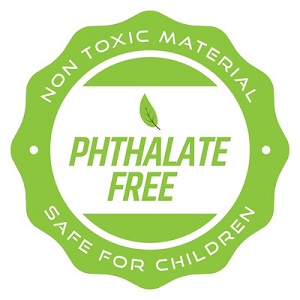The Problem With Phthalate Exposure
by Wendy Priesnitz
 There are many substances lurking in common personal and household products that are harmful for pregnant women and children. A common one is a class of chemicals called phthalates, which are used as plasticizers in numerous consumer items. They make polyvinyl chloride flexible and hold color and scents in certain products. Since the chemicals are not bound to the products, they can leach out and cause health problems for the user. Phthalates have been found to be endocrine disruptors, and linked to birth defects, breast cancer, abdominal obesity and insulin resistance in men, and allergies and asthma in children. There are many substances lurking in common personal and household products that are harmful for pregnant women and children. A common one is a class of chemicals called phthalates, which are used as plasticizers in numerous consumer items. They make polyvinyl chloride flexible and hold color and scents in certain products. Since the chemicals are not bound to the products, they can leach out and cause health problems for the user. Phthalates have been found to be endocrine disruptors, and linked to birth defects, breast cancer, abdominal obesity and insulin resistance in men, and allergies and asthma in children.
Research has indicated phthalates can interfere with reproductive and thyroid hormones.A study published in the peer-reviewed journal Environmental Health Perspectives says that women with higher exposure to phthalates during their pregnancy report more disruptive and problem behaviors in their children, using standardized measures. The study included 188 children whose mothers enrolled in Mount Sinai School of Medicine’s New York Children’s Environmental Health Study during their third trimester of pregnancy.
The researchers previously reported that prenatal phthalate exposure was associated with changes in newborn behavior, and their current objective was to assess their potential impact on neurobehavioral development in older children. Ten phthalate metabolites were measured in the mothers’ urine collected during the third trimester of pregnancy. Mothers were interviewed one to three times while their children were 4 to 9 years old. Each time, the mothers completed standard questionnaires to assess their children’s behavior and cognitive functioning.
The researchers found that prenatal exposure to a group of phthalates commonly found in personal care products was significantly associated with poorer scores for problems with aggression, conduct, and emotional control. Associations did not appear to differ between boys and girls overall, and associations were stronger as levels of exposure increased. However, few children’s scores fell within the “at risk” or “clinically significant” range.
This study was the first to evaluate the neurobehavioral development of older children in relation to their phthalate exposure before birth. The data from this study are not sufficient to diagnose clinical conditions such as attention deficit/hyperactivity disorder. However, the results highlight an urgent need to further explore the relationship between phthalates and neurodevelopment.
The research was supported by NIEHS/EPA Children’s Center grants, the New York Community Trust, and the Agency for Toxic Substances and Disease Registry. Support was also provided by the National Institute of Child Health and Human Development.
Europe and some U.S states ban or limit manufacturers' use of phthalates. Canadian restrictions on the use of six phthalates in children’s plastic toys and some child-care products came into effect in 2011. Canadian restrictions limit the allowable concentrations of DEHP, DBP and BBP to no more than 1,000 milligrams per kilogram in the soft vinyl of all children’s toys and child-care products. They also restrict the permitted concentrations of DINP, DIDP and DNOP to no more than 1,000 mg/kg in the same products where children under four years old might put the soft vinyl in their mouths.
Since 1998 in Canada, there has been a voluntary industry ban on marketing soft vinyl products meant to be put in the mouths of young children, such as pacifiers, teethers, rattles, and baby bottle nipples if they contain the phthalates DINP and DEHP. However, that voluntary action only covered a portion of the danger because it didn’t include soft vinyl toys and child-care articles, which also contain phthalates.
However, phthalates can still be used in a wide range of other consumer products, including perfumes, nail polish, household cleaners, vinyl flooring, detergents, lubricants, food packaging, soap, paint, shampoo, air fresheners, and plastic bags. So it’s important to read labels on these products and avoid those with phthalates.
Wendy Priesnitz is Natural Child Magazine's founder and editor. She is a journalist with more than 40 years of experience, the author of 13 books, and the mother of two adult daughters. For more information and help avoiding these phthalates, see her book Natural Life Magazine’s Green & Healthy Homes.)
|

